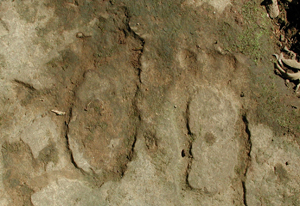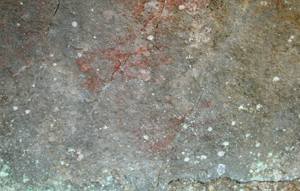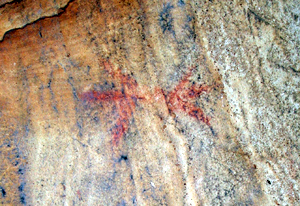Footprints, Handprints, and Animal Tracks
By Deborah Sabo
Arkansas rock art includes examples of footprint, handprint, and animal track motifs. These kinds of images are found around the world in many cultures and time periods. One of the intriguing questions in such a case is whether there might be a similarity of meaning to this type of iconography over such a wide distribution. If so, the best way to explain it would probably be because it is a very simple kind of image that has an “obvious” association to the communication needs and way-of-life of people who made rock art. Lets look at some of these possibilities, after describing the images found in Arkansas. All the footprint images we know about are petroglyphs. They are generally life-sized and occur singly, in pairs, and occasionally in groups.
Most handprints were made by first drawing the outline. Some were then filled in with paint. A few examples do not have an outline, and these may be the actual prints of paint-covered hands pressed onto the rock surface. Only two handprint images are petroglyphs (made by pecking rather than painting). Some archeologists, working with ethnographic evidence from different parts of the world, believe that rock art handprints represent the passage of the human soul from the Middle World into the spiritual realm through the rock face boundary separating the two realms. Animal tracks in Arkansas are three-toed footprints and stick-like bird or “turkey” tracks.
It might seem odd to include the footprints and handprints along with animal tracks. Indeed, it’s possible that the human prints have very different meanings. |
| Home | Quick Facts | Interpretations | Articles | Technical Papers | Resources | Database | Just For Kids | Picture Gallery | Buy the Book! |
|
Last Updated: April 12, 2007 at 4:09:07 PM Central Time
|



